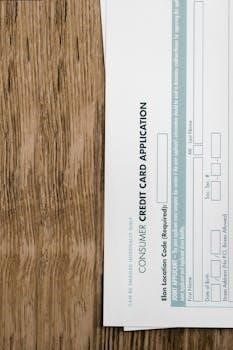Ontario Rental Application Form 410⁚ An Overview
The Ontario Rental Application Form 410 is a standardized document used in Ontario‚ Canada. It facilitates the rental application process‚ gathering essential information from prospective tenants. Landlords use this to assess an applicant’s suitability for renting a property.
What is Form 410?
Form 410‚ also known as the Rental Application Residential form‚ is a standardized document created by the Ontario Real Estate Association (OREA). It’s designed for prospective tenants to provide landlords with necessary details when applying to rent a residential property in Ontario. This comprehensive form collects personal information‚ employment history‚ rental history‚ and references. Landlords utilize Form 410 to evaluate potential tenants’ creditworthiness and overall suitability. It plays a crucial role in the tenant selection process‚ ensuring landlords have the information needed to make informed decisions. Properly completing Form 410 is a key step for anyone seeking to rent in Ontario.

Purpose of the Rental Application
The rental application’s main purpose is to enable landlords to gather essential information about prospective tenants. This allows landlords to assess their suitability and make informed decisions regarding renting their property.
Tenant Selection
The Ontario Rental Application Form 410 plays a crucial role in tenant selection. Landlords utilize the information provided to evaluate potential tenants‚ ensuring they meet the necessary criteria. This process involves verifying personal details‚ assessing rental history‚ and contacting references. By carefully reviewing applications‚ landlords can identify responsible and reliable tenants‚ minimizing potential issues and ensuring a positive renting experience for both parties. The form helps landlords to select candidates who are likely to fulfill their obligations‚ promoting a harmonious landlord-tenant relationship and protecting their investment. Ultimately‚ this contributes to the stability and success of the rental property.
Creditworthiness Assessment
A primary function of the Ontario Rental Application Form 410 is to enable landlords to assess the creditworthiness of prospective tenants. The form collects detailed financial information‚ allowing landlords to evaluate an applicant’s ability to meet their rental obligations. This assessment often involves reviewing employment details‚ income verification‚ and banking information. Landlords may also conduct credit checks with the applicant’s consent to gain further insight into their financial history. By thoroughly evaluating creditworthiness‚ landlords can mitigate the risk of rent defaults and financial losses. This ensures they choose tenants who can consistently pay rent on time‚ safeguarding the property’s income stream and maintaining its financial stability.

Key Sections of Form 410
Form 410 includes sections for personal information‚ employment details‚ and rental history. These sections collect vital data‚ enabling landlords to evaluate potential tenants effectively. Accurate completion is crucial for a successful application.
Personal Information
The “Personal Information” section of Form 410 requires applicants to provide their full name‚ date of birth‚ and contact details. This includes phone numbers and email addresses‚ ensuring landlords can easily reach the applicant. Additionally‚ this section typically asks for current and previous addresses‚ offering a view of the applicant’s residential history. Providing accurate data in this segment is crucial‚ as it forms the foundation for verifying the applicant’s identity and background. Landlords rely on this information to initiate further checks and assessments‚ making it a pivotal part of the application.
Employment Details
The employment details section of Form 410 is where applicants outline their current and past job history. Landlords use this information to evaluate an applicant’s income stability. Applicants must provide the names and addresses of their employers. This section also includes details about their job titles‚ salaries‚ and duration of employment. Providing proof of employment‚ such as pay stubs or employment letters‚ is often required to verify this data. Accurate and complete employment details are essential‚ as they play a significant role in determining the applicant’s ability to meet rental obligations.
Rental History and References
This part of Form 410 focuses on the applicant’s previous rental experiences. It requires a list of past landlords‚ their contact information‚ and the duration of each tenancy. Landlords use this to assess the applicant’s behavior as a tenant and their history of fulfilling rental obligations. Additionally‚ applicants must provide references who can vouch for their responsibility and character. These references should be individuals who are not related to the applicant. Providing accurate contact information is vital‚ as landlords will contact these references to gather insights into the applicant’s suitability as a tenant.

Completing and Submitting Form 410
Completing Form 410 accurately and submitting it properly are vital steps. Applicants should provide truthful information and gather supporting documents. Submissions can be in person‚ by mail‚ or online‚ depending on the landlord’s preference.
Accurate Information
Providing accurate information on Form 410 is paramount for a successful rental application. Landlords rely on the truthfulness of the data to make informed decisions about potential tenants. Any misrepresentation or falsification of details can lead to the rejection of the application. Ensure that all personal details‚ employment history‚ and rental references are correct and verifiable. Double-check spellings and dates to avoid unintentional errors. Honest and transparent disclosure builds trust with the landlord and demonstrates a commitment to a responsible tenancy‚ increasing the chances of approval for the desired rental property.
Required Supporting Documents
To strengthen a rental application‚ it’s essential to include the required supporting documents alongside Form 410. These documents provide verification and validation of the information provided. Common examples include proof of income‚ such as pay stubs or employment letters‚ and photo identification‚ such as a driver’s license or passport. Some landlords may also request credit reports or bank statements to assess financial stability. Gathering these documents beforehand streamlines the application process‚ demonstrating preparedness and diligence. Ensure that all copies are clear and legible‚ further enhancing the overall impression and increasing the likelihood of a favorable review by the landlord.
Submission Methods
Submitting Form 410 can be done through various methods‚ depending on the landlord’s preferences. Traditional options include in-person delivery or mailing the application to the property management company. Many landlords now offer online submission portals for convenience. These portals allow applicants to upload the completed form and supporting documents electronically. Ensure you follow the landlord’s specified method. For in-person submissions‚ confirm office hours. If mailing‚ consider registered mail for tracking. Online submissions often provide immediate confirmation. Always keep a copy of the submitted application and any accompanying documents for your records‚ regardless of the chosen method.

Legal Considerations
Submitting Form 410 involves understanding legal rights and obligations for both landlords and applicants. Landlords can request necessary information‚ but applicants must consent and be aware of privacy rights concerning their personal data during the rental process.
Landlord’s Right to Request Information
In Ontario‚ landlords have the right to request information from prospective tenants using Form 410 to assess their suitability. This includes details about employment‚ rental history‚ and creditworthiness. This information helps landlords make informed decisions when selecting tenants for their properties. However‚ landlords must adhere to the Human Rights Code and cannot discriminate against applicants based on protected grounds. The requested information must be relevant and necessary for evaluating the applicant’s ability to fulfill the tenancy obligations. Landlords should also handle this information responsibly‚ respecting the privacy of the applicants throughout the process.
Applicant’s Consent and Privacy
When completing Form 410‚ applicants provide consent for landlords to collect and use their personal information. This consent is essential for landlords to conduct necessary background checks and assess the application. Applicants have the right to understand how their information will be used and protected. Landlords are obligated to handle personal data responsibly and in compliance with privacy laws. Applicants should be aware of their rights regarding data protection and can request access to or correction of their information. It’s crucial for landlords to maintain confidentiality and only use the information for tenancy-related purposes‚ ensuring respect for applicant privacy.
Standard Lease vs. Rental Application
The rental application (Form 410) precedes the standard lease. It gathers applicant information‚ while the lease is a legally binding agreement outlining tenancy terms and conditions upon approval.
Distinction Between the Two
The key distinction lies in their purpose and timing. The rental application‚ often OREA Form 410‚ is a preliminary step. It serves to collect information from prospective tenants‚ allowing landlords to evaluate their suitability. This includes details about employment‚ rental history‚ and creditworthiness. The standard lease‚ on the other hand‚ is a legally binding agreement. It outlines the terms and conditions of the tenancy‚ such as rent amount‚ lease duration‚ and responsibilities of both the landlord and tenant. The lease is only executed after the landlord approves the rental application and agrees to rent the property to the applicant;
Resources for Tenants and Landlords
OREA‚ the Ontario Real Estate Association‚ provides standard forms like Form 410. They also offer educational resources. Other organizations and legal aid clinics offer assistance and information regarding tenant and landlord rights in Ontario.
OREA and Other Organizations
The Ontario Real Estate Association (OREA) is a primary resource‚ providing the standard Form 410 and related guidance for its members. OREA’s resources help ensure standardized and legally sound rental application processes. Beyond OREA‚ various organizations offer support and information to both tenants and landlords in Ontario. These include legal aid clinics that provide free legal assistance and advice. Government websites offer detailed information on tenant rights and landlord responsibilities‚ promoting fair rental practices. Accessing these resources ensures a smoother and more informed rental experience for all parties involved.